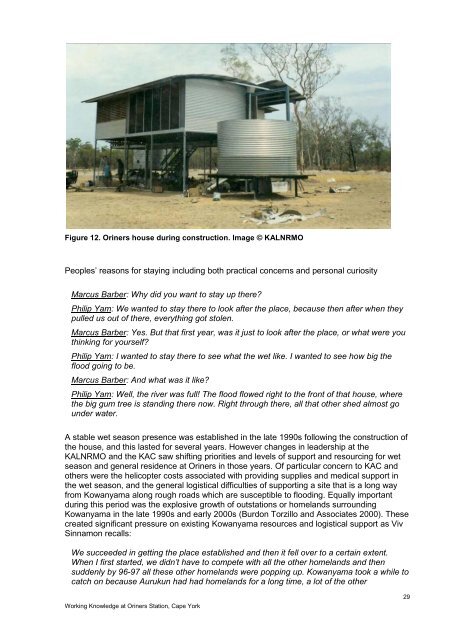WfHC - cover page (not to be used with pre-printed report ... - CSIRO
WfHC - cover page (not to be used with pre-printed report ... - CSIRO
WfHC - cover page (not to be used with pre-printed report ... - CSIRO
Create successful ePaper yourself
Turn your PDF publications into a flip-book with our unique Google optimized e-Paper software.
Figure 12. Oriners house during construction. Image © KALNRMO<br />
Peoples‟ reasons for staying including both practical concerns and personal curiosity<br />
Marcus Bar<strong>be</strong>r: Why did you want <strong>to</strong> stay up there?<br />
Philip Yam: We wanted <strong>to</strong> stay there <strong>to</strong> look after the place, <strong>be</strong>cause then after when they<br />
pulled us out of there, everything got s<strong>to</strong>len.<br />
Marcus Bar<strong>be</strong>r: Yes. But that first year, was it just <strong>to</strong> look after the place, or what were you<br />
thinking for yourself?<br />
Philip Yam: I wanted <strong>to</strong> stay there <strong>to</strong> see what the wet like. I wanted <strong>to</strong> see how big the<br />
flood going <strong>to</strong> <strong>be</strong>.<br />
Marcus Bar<strong>be</strong>r: And what was it like?<br />
Philip Yam: Well, the river was full! The flood flowed right <strong>to</strong> the front of that house, where<br />
the big gum tree is standing there now. Right through there, all that other shed almost go<br />
under water.<br />
A stable wet season <strong>pre</strong>sence was established in the late 1990s following the construction of<br />
the house, and this lasted for several years. However changes in leadership at the<br />
KALNRMO and the KAC saw shifting priorities and levels of support and resourcing for wet<br />
season and general residence at Oriners in those years. Of particular concern <strong>to</strong> KAC and<br />
others were the helicopter costs associated <strong>with</strong> providing supplies and medical support in<br />
the wet season, and the general logistical difficulties of supporting a site that is a long way<br />
from Kowanyama along rough roads which are susceptible <strong>to</strong> flooding. Equally important<br />
during this period was the explosive growth of outstations or homelands surrounding<br />
Kowanyama in the late 1990s and early 2000s (Burdon Torzillo and Associates 2000). These<br />
created significant <strong>pre</strong>ssure on existing Kowanyama resources and logistical support as Viv<br />
Sinnamon recalls:<br />
We succeeded in getting the place established and then it fell over <strong>to</strong> a certain extent.<br />
When I first started, we didn‟t have <strong>to</strong> compete <strong>with</strong> all the other homelands and then<br />
suddenly by 96-97 all these other homelands were popping up. Kowanyama <strong>to</strong>ok a while <strong>to</strong><br />
catch on <strong>be</strong>cause Aurukun had had homelands for a long time, a lot of the other<br />
Working Knowledge at Oriners Station, Cape York<br />
29
















